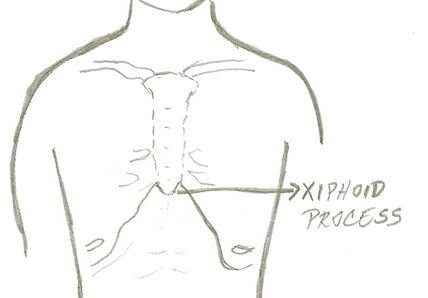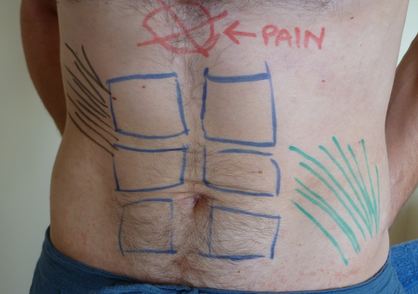Xiphoid Process
What is Xiphoid Process?
Xiphoid process is derived from the Greek word xiphos with Latin terminology ensiform, which both mean ‘similar to a sword or blade.’ It is also termed as metasternum, processus xiphoideus and xiphosternum. This is the smallest ossified cartilaginous structure at the distal portion of the sternum.
In newborns, it is a triangular hyaline cartilage region which gradually ossifies or calcifies into a bony material up to 40 years of age and fuses with the body of the sternum.
There could be variations in the appearance of the xiphoid process which may include: (1) a perforated appearance with foramen or opening at the center, or (2) with a division or bifurcation at its tip branching into right and left parts.

Image 1 – Xiphoid Process Location
Xiphoid Process Location (Anatomy)
The xiphoid process is the most inferior or lowest portion of the sternum found at the T6 dermatome and along the 9th thoracic vertebra level. It can be found in the anterior midline area of the thoracic cavity along with the entire sternum.

Image 2 – Anatomical Position of Xiphoid Process (highlighted)

Image 3 – Xiphoid Process in respect to Sternum parts and Ribs
Xiphoid Process Functions (Clinical Significance)
As a structure, it serves as an additional supportive anchor for the diaphragm, transverse thoracis muscle, and abs muscle or the rectus abdominis. Being the smallest of the sternal parts, xiphoid process is a significant anatomical landmark for clinical assessment.
Aside from its popularity in CPR chest compressions, it is also used in assessing the lower borders of the heart, superior margin of the liver, lower boundaries of the anterior thorax, checking the centermost diaphragmatic tendon and subcostal angle.
Xiphoid Process Pain

Image 4 – Xiphoid Sternum Pain Location
Xiphoid Process Pain Causes
1. Xiphoid Syndrome
Also known as xiphodynia or xiphoidalgia, refers to the discomfort and sharp pain felt at the xiphoid process and the structures attached to it. The pain is usually intensified by application of pressure on the chest, overeating and movements like stooping, twisting and bending.
The symptoms can be experienced for several minutes and may recur for weeks to months. It can be associated to several conditions, among which are cardiovascular disease, gallbladder disorder, bone abnormalities, neuropathy, multiple sclerosis and fibromyalgia.
The symptoms mimic certain thoracic and abdominal disorders which include, but not limited to chest pain, epigastric pain, radiating pain to the chest, arms, shoulders, neck and back.
2. Gastroesophageal Reflux Disease or GERD
Gastroesophageal Reflux Disease (GERD) is a disorder of the digestive system characterized by the backflow of gastric contents into the esophagus leading to irritation and erosion of the esophageal membranous lining.
In GERD, the junction muscle between the esophagus and the stomach known as the lower esophageal sphincter (LES)or cardiac sphincter becomes incompetent or weak allowing for the reflux of food and acidic gastric juices into the food pipe.
Hiatal hernia has long been considered a major factor in the development of GERD. This condition occurs when the gastric fundus or the upper most portion of the stomach is displaced up into the thoracic cavity through the diaphragmatic hiatus, an opening in the diaphragm. Contributory factors to hiatal hernia include pregnancy, obesity, physical exertion, straining, vomiting and forceful coughing.
The hallmark of GERD is acid indigestion or heartburn. The client complains of burning chest pain originating from the breastbone radiating to the neck and throat. The pressure and pain may last for several minutes to two hours and is worse after a meal. It can also be aggravated by supine or lying position and bending over.
3. Physical trauma
Direct undue pressure to the xiphoid process from wrong placement of compression hands in CPR may cause damage and possible breakage of this structure. If it is fractured, it can be pushed into the diaphragm or into other thoracic organs causing secondary injuries.
The break in the xiphoid is often reported by the client with a ‘popping sensation.’ Damage to the xiphoid can also be brought about by collision or impact injury. This is further compounded by rib fractures and dislocation.
4. Xiphoid process protrusion
Protruding xiphoid process can be related to significant weight loss but often do not complain of pain. In obesity, this can be due to the additional pressure being exerted by the visceral fat against the thoracic organs and rib cage. Since the xiphoid is a cartilaginous structure, it can be easily pushed away from its position and protrude or stick out.
Xiphoid Process Pain Treatment
When a client complains of xiphoid process pain, further physical exam, health history taking and additional diagnostic tests are done to determine the underlying cause and rule out other disorders. While some cases with xiphoid pain resolves with minimal management, more extensive regimens are warranted in severe cases.
Xiphoid syndrome as a self-limiting problem can be symptomatically managed with analgesics, hot and cold compress applications, elastic rib belt and therapeutic reassurance.
If unresponsive, however, the regimen of choice is xiphoid injection with steroids and local anesthetics. The use of physical therapies is not yet sufficiently established in managing xiphodynia.
Symptomatic relief of GERD can be obtained by maintaining an upright position post meal and intake of antacids. Changes in the dietary practices and lifestyle reduce reflux and prevent further damage to the already implicated esophagus. Clients with GERD are advised to refrain from taking in alcohol, caffeine, chocolate, fatty food and peppermint which can weaken the LES.
Food and drinks which are irritating to the esophageal membrane should be minimized or avoided. Examples are citrus fruits and juices, spices and tomato derivative products. For severe cases non-responsive to medication, surgery is a viable option. Nissen Fundoplication is a surgical technique done to strengthen the LES and prevent reflux.
Pain and swelling of the xiphoid related to physical injury or trauma should not be neglected. Analgesics and anti-inflammatory drugs are commonly ordered to alleviate these. The use of rib belt restricts unnecessary movements and provides for the alignment of the injured structure for healing. Heavy lifting and strenuous activities are also avoided to prevent further irritation and damage to the xiphoid process.
